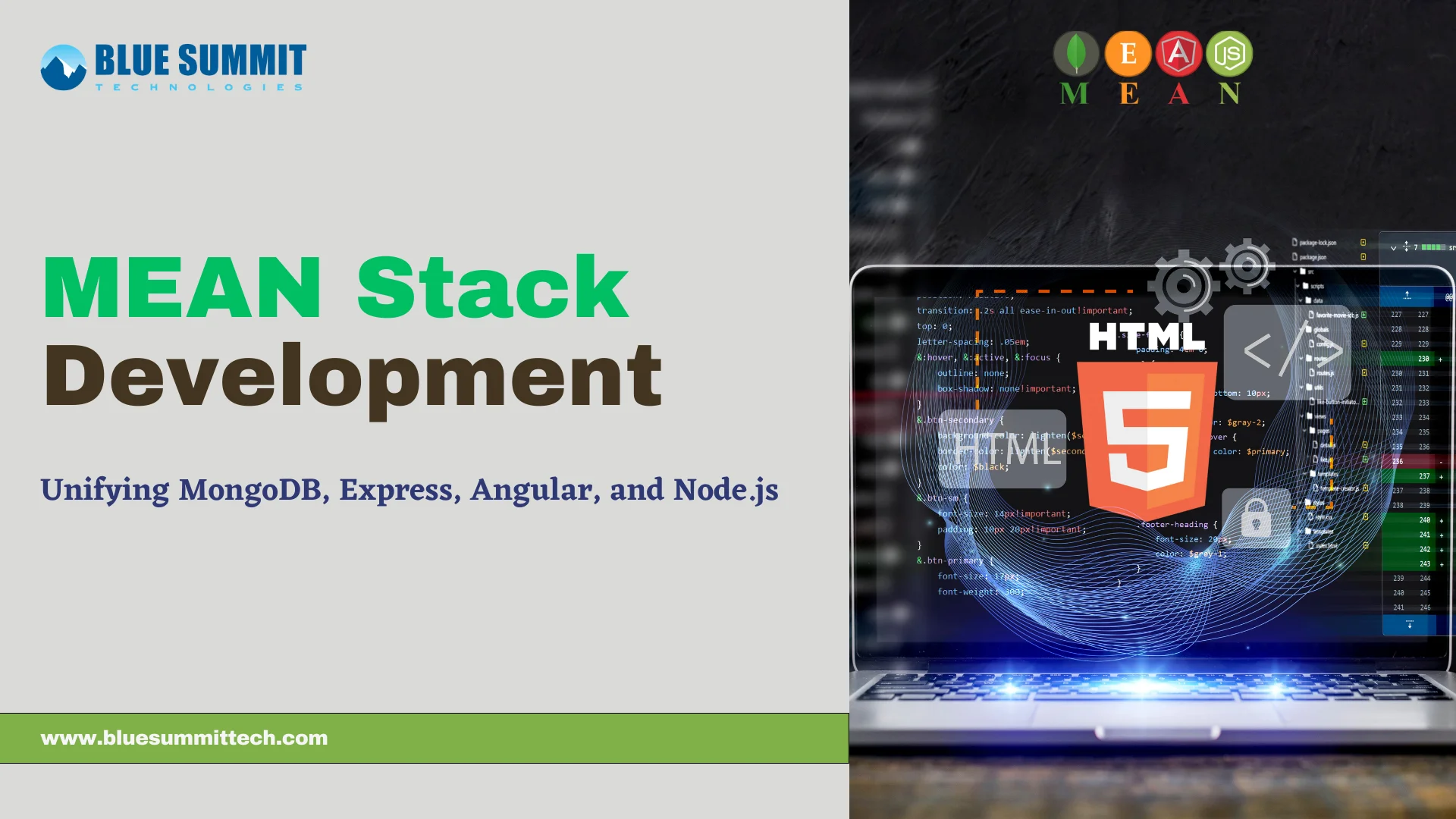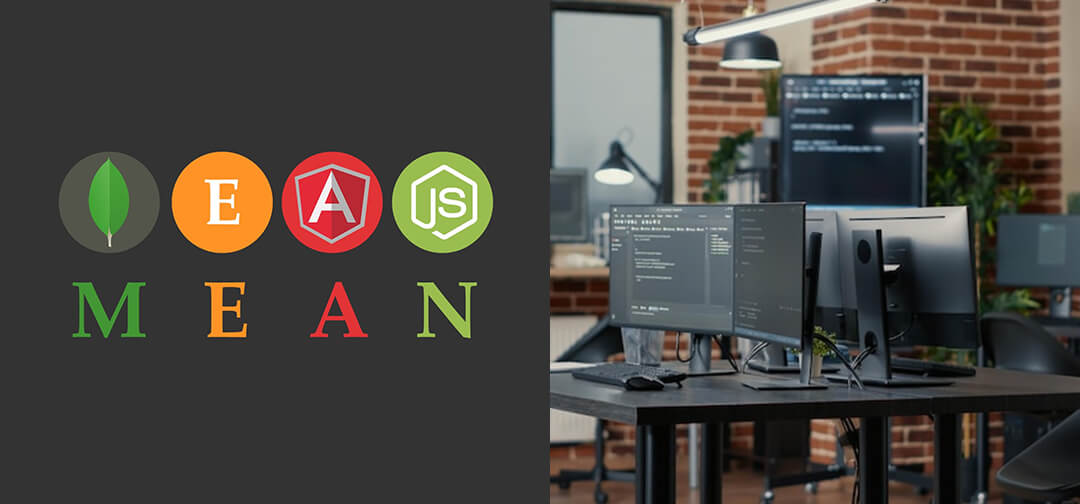
Posted on Tuesday, Jun 27th, 2023
MEAN Stack: Unveiling the Power of Full Stack Development
Web development has become a vital skill for aspiring programmers these days and full stack development, in particular, offers a comprehensive approach to building dynamic and robust web applications. Among the various full stack frameworks available, MEAN Stack stands out for its versatility and power. Below in the blog we will dive dipper into the world of MEAN Stack development, unravelling its components and showcasing its immense potential.
What is MEAN Stack?
To understand MEAN Stack, we need to break down its acronym: MongoDB, Express.js, Angular, and Node.js. Each component plays a crucial role in the stack, and together they form a powerful ecosystem for building modern web applications.Building with MongoDB
i. MongoDB, a NoSQL database, forms the foundation of the MEAN Stack.ii. With its flexible and schema-less nature, MongoDB allows for seamless scalability and adaptability to evolving data requirements.
iii. It excels in handling unstructured and semi-structured data, making it ideal for projects involving big data, content management systems, and real-time analytics.
To know more about MongoDB refer our blog https://www.bluesummittech.com/blog/mongodb-development/.
Creating Dynamic Web Applications with Express.js
i. Express.js, a lightweight and flexible web application framework, serves as the backend component of MEAN Stack.ii. It offers a range of features and middleware that streamline the handling of HTTP requests, routing, and views. With its intuitive routing system, developers can easily define endpoints and map them to specific actions, making it effortless to create APIs and handle various HTTP methods.
iii. Express.js also allows for the integration of middleware functions, enabling developers to add custom logic and modify request and response objects.
Powering Interactive User Interfaces with Angular
Angular, a powerful JavaScript framework, serves as the frontend component of MEAN Stack. It follows the Model-View-Controller (MVC) architectural pattern, providing a structured approach to development. Its strength lies in its features, including two-way data binding, dependency injection, and component-based architecture.i. With two-way data binding, any changes made to the user interface automatically update the underlying data model, and vice versa, simplifying the development process and enhancing productivity.
ii. Angular's dependency injection system promotes code reusability, maintainability, and testability by allowing components to easily access and use external dependencies.
iii. The component-based architecture of Angular promotes modularization and reusability, enabling developers to build complex applications by composing smaller, reusable components.
Additionally, Angular offers a rich ecosystem of libraries, tools, and extensions, making it highly versatile and adaptable to various development needs. With its comprehensive features and robust community support, Angular empowers developers to create sophisticated web applications with ease, scalability, and maintainability.
Asynchronous Programming with Node.js
i. Node.js, a runtime environment, powers the server-side logic in MEAN Stack. Unlike traditional server-side technologies, Node.js operates on a non-blocking, event-driven architecture, making it ideal for handling concurrent requests and real-time applications.ii. With Node.js, developers can leverage JavaScript's familiarity and versatility to seamlessly transition from frontend to backend development.
iii. Node.js excels at handling I/O-intensive tasks, such as network communication and file system operations, by employing asynchronous programming techniques. This approach enables Node.js applications to efficiently process multiple requests without blocking the execution flow.
Additionally, Node.js boasts a vast ecosystem of open-source libraries and modules, known as npm, that provide a wealth of ready-to-use functionality for building a wide range of applications. Node.js has revolutionized the world of server-side development, empowering developers to create fast, scalable, and event-driven applications with ease.
Potentials of Mean Stack
Let's explore some of the key potentials of MEAN Stack:1. Full Stack Development
MEAN Stack empowers developers to work seamlessly across the entire web application stack. From database management with MongoDB to backend development with Express.js and Node.js, and frontend design with Angular, developers have the ability to handle all aspects of the application development process.2. JavaScript Synergy
This is entirely built on JavaScript, enabling developers to leverage their existing JavaScript skills and knowledge. This creates a cohesive development environment, making it easier to switch between frontend and backend tasks and reducing the learning curve for developers.3. Flexibility and Scalability
It offers flexibility in terms of data modeling and schema-less databases like MongoDB. This flexibility allows for easy adaptation and modification of data structures as application requirements evolve. Additionally, the use of Node.js provides scalability, as it can handle a large number of concurrent requests efficiently.4. Rapid Prototyping
This provides a robust set of tools, libraries, and frameworks that facilitate rapid prototyping and development. The modular architecture of MEAN Stack components allows for reusability of code, reducing development time and effort.5. Real-Time Applications
With its event-driven and non-blocking I/O model, this is well-suited for building real-time applications. Node.js enables the handling of multiple concurrent connections, making it ideal for applications requiring instant updates and live communication.6. Cloud Compatibility
It seamlessly integrates with cloud-based platforms, making it easy to deploy and scale applications. The ability to leverage cloud infrastructure allows for cost-effective and efficient deployment of MEAN Stack applications.7. Robust Community Support
It benefits from a large and active community of developers who contribute to the continuous improvement and development of the individual components. This vibrant community ensures that MEAN Stack stays up-to-date with the latest trends, tools, and best practices.MEAN Stack Development Tools
Mean Stack development involves the use of various tools and techniques to create efficient and robust web applications. Here are some commonly used tools and techniques in MEAN Stack development:npm (Node Package Manager)
npm is a package manager for Node.js that provides access to a vast ecosystem of open-source libraries and modules. It allows developers to easily incorporate third-party packages into their MEAN Stack applications, saving time and effort in development.Mongoose
Mongoose is an Object Data Modeling (ODM) library for MongoDB. It provides a straightforward way to define data schemas, perform validations, and interact with MongoDB from Node.js, simplifying database operations in MEAN Stack applications.Gulp and Webpack
Gulp and Webpack are build tools that automate tasks such as bundling, minification, and code optimization in MEAN Stack applications. They help streamline the development process and improve performance.RESTful APIs
MEAN Stack applications often utilize RESTful APIs (Representational State Transfer) for communication between frontend and backend. RESTful APIs provide a standard, stateless way of interacting with server resources and are widely used in MEAN Stack development.Testing Frameworks
Tools like Mocha, Chai, and Jasmine are commonly used testing frameworks for unit testing and integration testing in MEAN Stack development. They help ensure the reliability and functionality of the application.Version Control
Git is a widely adopted version control system that enables efficient collaboration, code management, and tracking changes in MEAN Stack projects. Platforms like GitHub and GitLab facilitate seamless teamwork and code repository hosting.Advantages of Mean Stack
1. Single Language
It utilizes JavaScript as the primary programming language throughout the entire development stack. This enables developers to use a consistent language for both frontend and backend development, reducing the learning curve and promoting code reusability.2. Full Stack Development
This covers the complete web application development stack, from the database layer (MongoDB) to the server-side (Express.js and Node.js) and the client-side (Angular). This comprehensive approach allows developers to handle all aspects of the application within a single framework, resulting in increased efficiency and reduced complexity.3. Code Reusability
MEAN Stack promotes code reusability by utilizing a component-based architecture. Angular allows developers to create reusable components for building user interfaces, while Node.js enables the reuse of JavaScript code on the server-side. This reduces redundancy and speeds up the development process.4. Flexibility and Scalability
MongoDB, a NoSQL database, offers flexibility in data modeling and schema-less document storage. This allows for easy adaptation to changing requirements and seamless scalability as the application grows. Additionally, Node.js employs a non-blocking, event-driven architecture, making it highly scalable and capable of handling concurrent connections efficiently.5. Rapid Prototyping
It provides a set of robust tools, libraries, and frameworks that facilitate rapid prototyping and development. Angular offers a rich set of UI components, Express.js simplifies backend development, and Node.js provides a fast runtime environment. This combination of tools accelerates the development process and enables quick iteration.6. Cost-Effective
It leverages open-source technologies, eliminating the need for expensive commercial licenses. MongoDB, Express.js, Angular, and Node.js are all open-source and freely available, making it a cost-effective choice for web application development.7. Cloud Compatibility
It is well-suited for cloud-based deployments. With the use of platforms like AWS, Microsoft Azure, or Google Cloud, developers can easily deploy and scale MEAN Stack applications. This allows for efficient utilization of resources, cost optimization, and simplified management.Conclusion
Mean Stack development offers a powerful and versatile framework for building modern, dynamic web applications. By combining MongoDB, Express.js, Angular, and Node.js, developers gain access to a comprehensive set of tools and technologies that enable them to create feature-rich and scalable solutions.Experience effortless and accessible web development with Blue Summit. Our team of skilled and seasoned developers is ready to assist you every step of the way. From concept to execution, we make web development a breeze, ensuring seamless and exceptional results. Trust Blue Summit to simplify your journey and deliver outstanding web solutions tailored to your needs.
Blue Summit has collaborated with OdiTek Solutions, a frontline custom software development company. It is trusted for its high service quality and delivery consistency. Visit our partner's page to720day and get your business streamlined.
REFER TO OTHER RELEVANT CONTENTS

MEAN Stack Development
It's crucial to have a standardized, consistent software stack when creating a new application. Utilizing a collection of solutions that are made to function together will simplify resources and cut down on development time for your back-end. The stack field is becoming congested, though. There...
read more







